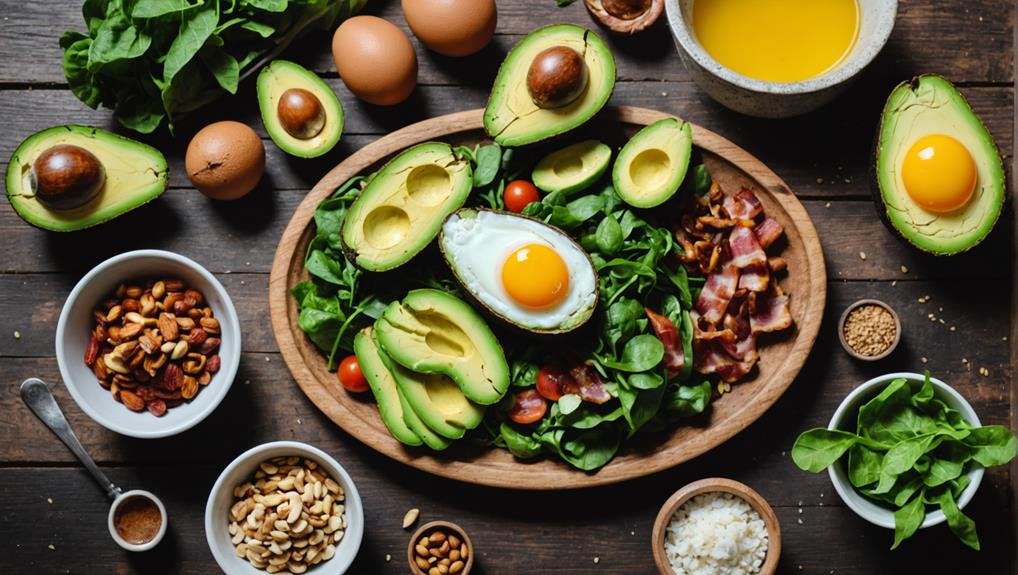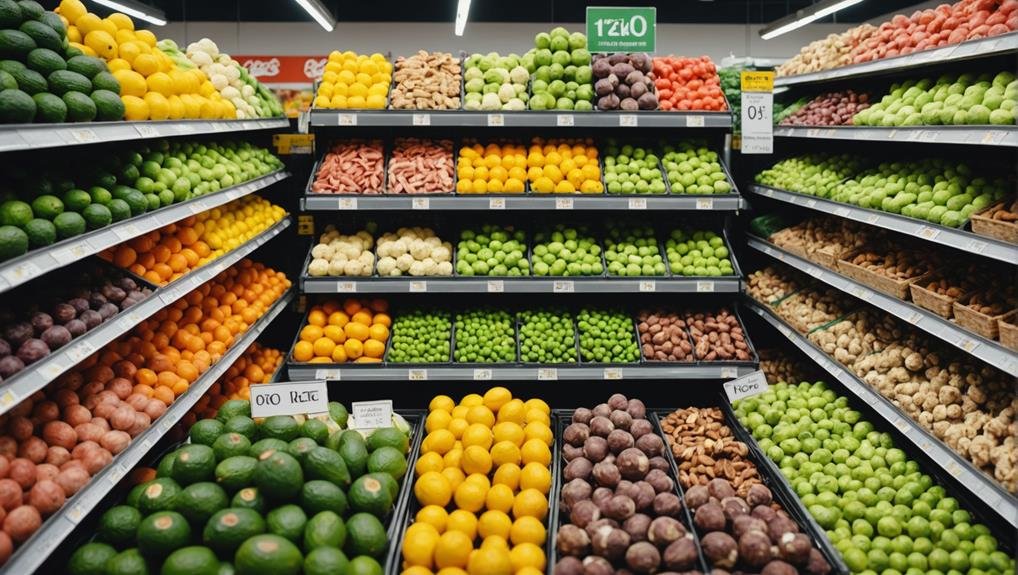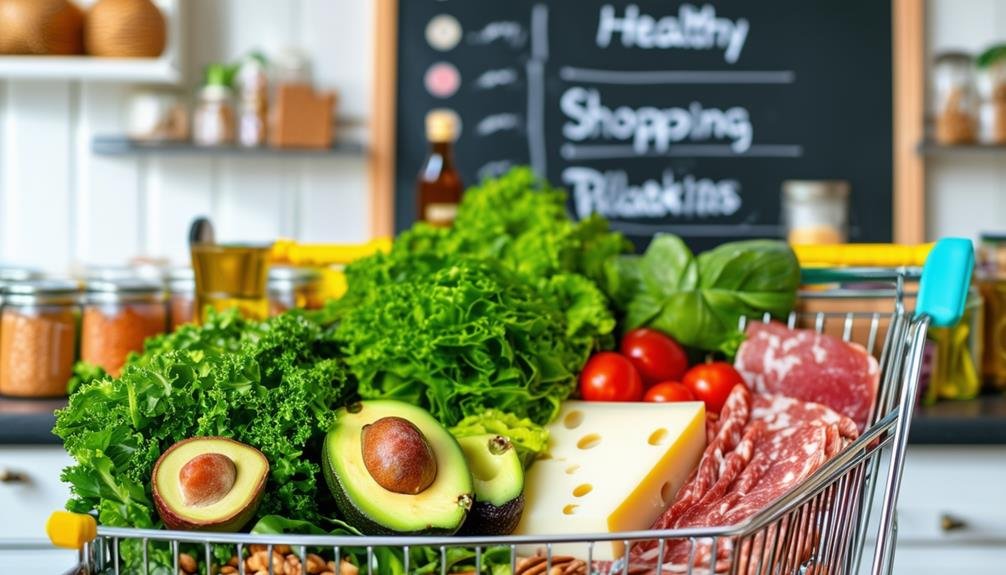To kickstart your keto diet, it's essential to form a comprehensive shopping list that focuses on high-quality fats, low-carb vegetables, and rich protein sources.
Start by gathering healthy fats such as olive oil, coconut oil, and avocados.
For vital nutrients, incorporate low-carb vegetables like leafy greens, broccoli, and cauliflower.
Select quality protein sources, including grass-fed beef, dark meat chicken, and fatty fish.
Additionally, consider adding keto-friendly fruits like avocados and berries with low sugar content.
Make sure to stock up on pantry staples, such as almond flour and sugar-free sweeteners, to aid in your cooking endeavors.
This foundational list will set you on the path to success in your keto journey, allowing you to discover more tips along the way.
Key Takeaways
- Emphasize healthy fats such as olive oil and coconut oil, aiming for these to make up 70% of your total daily caloric intake.
- Include low-carb vegetables like spinach and broccoli to keep carbohydrate consumption between 30-50 grams per day.
- Select high-quality protein sources, including grass-fed beef and dark meat chicken, to fulfill protein requirements while ensuring a high fat intake.
- Stock up on keto-friendly sweeteners like stevia and erythritol to use for baking and creating low-carb desserts.
Understanding Keto Basics
The ketogenic diet is designed to transition your body into a state of ketosis, where it predominantly burns fat for energy rather than carbohydrates. This diet is characterized by an ultra-low carbohydrate intake paired with a high intake of healthy fats. If you're considering this diet, grasping the fundamentals is crucial. The main objective is to limit your daily carbohydrate consumption to approximately 30-50 grams, facilitating the shift into ketosis.
Typically, the macronutrient ratio in a ketogenic diet consists of around 70% fats, 25% proteins, and a mere 5% carbohydrates. By selecting low-carb options, you allow your body to become more efficient at utilizing fat as its primary fuel source. Healthy fats can be sourced from items such as nuts, avocados, and oils, while protein sources may include meats, eggs, and certain dairy products.
Effective meal planning is essential on this diet, requiring you to avoid high-glycemic foods that can spike blood sugar levels. Your grocery shopping should prioritize whole foods, steering clear of processed items that frequently contain hidden sugars and carbohydrates. It's important to develop a comprehensive grocery list encompassing a variety of approved foods to support your dietary goals and maintain momentum in your weight loss journey.
Mastering these keto basics will pave the way for your success. Once you're well-acquainted with the types of foods that align with the ketogenic lifestyle, adhering to the diet becomes more straightforward, ultimately enriching your overall dietary experience.
Macronutrient Guidelines
Understanding macronutrient guidelines is crucial for maintaining ketosis on a ketogenic diet. This diet typically requires a macronutrient ratio of approximately 70-80% fat, 10-20% protein, and 5-10% carbohydrates. To successfully achieve ketosis, it's vital to restrict daily carbohydrate intake to around 30-50 grams of net carbs, calculated by subtracting dietary fiber from total carbohydrates.
Here's a concise overview of macronutrient targets for a standard 2,000-calorie diet:
| Macronutrient | Daily Target |
|---|---|
| Fat | ~167 grams (70-80%) |
| Protein | ~100 grams (10-20%) |
| Carbohydrates | ~25 grams (5-10%) |
When creating your keto grocery list, prioritize high-fat and low-carb foods, such as avocados, olive oil, and nuts. Protein should be consumed in moderation to avoid gluconeogenesis, which can interfere with ketosis. Incorporating healthy options like leafy greens and low-carb vegetables will help you meet your nutritional needs without exceeding your fat macros or net carbohydrate limits.
Maintaining the appropriate macronutrient balance is essential for effective fat metabolism and sustained ketosis. Deviations from these targets may impede your body's ability to utilize fat as energy. Focus on keto-friendly foods, and you'll be well-equipped to reach your dietary objectives.
Essential Keto Grocery List

When starting the keto diet, having a well-curated grocery list can streamline your shopping experience.
Focus on essential foods such as healthy fats, low-carb vegetables, and high-quality proteins to ensure your meals stay keto-friendly.
Additionally, implementing smart shopping strategies can help you stay within budget while sourcing the right ingredients to support your keto lifestyle.
Must-Have Foods
Essential components of a keto diet include healthy fats, low-carb vegetables, quality protein sources, keto-friendly fruits, and vital pantry staples.
Begin with healthy fats such as olive oil, coconut oil, and avocado oil, which should account for approximately 70% of your daily caloric intake.
Following that, include low-carb vegetables like leafy greens, broccoli, and cauliflower on your keto grocery list to provide essential nutrients while keeping net carbs in check.
For your protein sources, prioritize grass-fed beef, dark meat chicken, pork, and fatty fish to constitute around 25% of your daily calories.
Incorporate keto-friendly fruits, including avocados and low-sugar berries like blackberries and raspberries, as they can satisfy sweet cravings while staying within your carbohydrate allowance.
Additionally, stock your pantry with convenient staples. Almond flour is a great choice for low-carb baking, while sugar-free sweeteners such as stevia and erythritol can help satisfy your sweet cravings without increasing your carb intake.
Dark chocolate also serves as a delightful treat.
Collectively, these essential foods will create a solid foundation for your meal planning while adhering to your keto lifestyle.
Shopping Tips
As you embark on your keto journey, prioritizing high-quality ingredients will help you stay within your carb limits while enjoying flavorful meals.
Begin your keto shopping list with high-quality fats, such as olive oil, coconut oil, and grass-fed butter, which should comprise approximately 70% of your daily caloric intake.
Incorporate a diverse range of low-carb vegetables like spinach, broccoli, and cauliflower to support digestive health and keep your carb intake below 50 grams per day.
Include protein sources that complement the keto diet, such as fatty cuts of beef, chicken thighs, pork, and fatty fish like salmon, which should contribute around 25% of your daily calories from protein.
For low-carb baking, opt for almond flour and keto-friendly sweeteners like stevia or erythritol.
Furthermore, add healthy snacks to your shopping cart, such as macadamia nuts, pecans, cheese, and low-carb berries.
These choices won't only help you maintain your diet but also provide enjoyable and satisfying meal options, reducing the temptation of high-carb snacks between meals.
Pantry Staples & Miscellaneous
When stocking your pantry for a keto diet, it's essential to include core baking ingredients like almond flour, which can serve as a substitute for traditional flours in various recipes.
Low-carb sweeteners such as monk fruit and stevia allow you to indulge in your favorite desserts without adversely affecting your blood sugar levels.
Also, remember to incorporate flavor enhancers like fresh herbs and spices; they can elevate your meals while maintaining a low carbohydrate count.
Essential Baking Ingredients
Having the right baking ingredients is crucial for creating delicious keto-friendly treats. For your Keto Grocery List, start with almond flour and coconut flour. Almond flour provides healthy fats and a nutty flavor, making it ideal for various keto recipes. Coconut flour, high in fiber, effectively absorbs moisture, allowing you to use less than traditional flours in your baking.
Sweeteners are essential for achieving the right level of sweetness in low-carb desserts. Opt for keto-friendly options such as monk fruit, stevia, and erythritol, which enable you to enjoy treats without adding sugar or carbs that could disrupt your keto diet.
Unsweetened cocoa powder is crucial for chocolate-flavored low-carb desserts due to its rich antioxidant content and low carbohydrate count. Additionally, baking powder and baking soda are key leavening agents that contribute to the desired texture in baked goods, ensuring they rise properly and stay fluffy without relying on high-carb ingredients.
These essential ingredients will guide you toward creating satisfying and delicious keto-friendly foods.
Sweeteners and Flavor Enhancers
Sweeteners and flavor enhancers are crucial for creating delectable keto meals and snacks, enabling you to savor rich flavors while staying within your carbohydrate limits.
Keto-friendly sweeteners such as monk fruit, stevia, and erythritol serve as excellent substitutes for sugar, largely maintaining stable blood sugar levels with minimal or no effects. By using these sweeteners, you can enjoy desserts and beverages without breaching your daily carb cap of 30-50 grams.
When selecting sweeteners, prioritize quality. Some processed sweeteners may contain hidden sugars or additives that can disrupt ketosis.
Sugar-free flavor enhancers like vanilla extract and unsweetened cocoa powder can enrich the flavor profile of your dishes without adding extra carbs or calories.
Additionally, fresh herbs can significantly enhance the taste of your recipes. Utilizing a variety of flavor enhancers not only makes cooking more enjoyable but also helps you preserve flavor while following your keto diet.
Shopping List by Store

Creating a tailored shopping list for each store can significantly enhance your keto journey. When assembling your keto grocery list, it's essential to consider the specific offerings at each location.
At Sprouts, seek high-quality keto yogurt varieties, keto baking essentials such as sugar-free chocolate chips, and low-carb snacks like Quest Chips to keep your snacking keto-friendly and enjoyable.
When you're at Publix, make sure to stock up on whipped cream, Little Chorizo Sausages from Quijote, and frozen keto meals from Real Good Foods. These items are convenient for meal prep and will help you maintain your keto lifestyle.
Walmart is another excellent stop for groceries. They carry Dukes Sausages, Macs Pork Rinds, chicken thighs, and bakers chocolate, all crucial ingredients for your low-carb baking and meal preparation.
Aldi provides budget-friendly choices that are beneficial for a keto diet, including Babybel cheese, avocados, heavy whipping cream, and flaxseeds, allowing you to stay on track financially while adhering to your diet.
Tips for Successful Shopping
To maximize your success on the keto diet, it's essential to plan your shopping trips carefully.
Start by creating a detailed list of essential ingredients. Begin with high-quality fats, such as olive oil, coconut oil, and butter, which should make up about 70% of your daily caloric intake.
Then, focus on selecting low-carb vegetables, including leafy greens, broccoli, and cauliflower, to help you stay within the recommended 30-50 grams of net carbs each day.
When shopping for proteins, opt for fatty cuts of meat like grass-fed beef or dark meat chicken. This choice will help you meet your protein needs while keeping your fat intake around 25% of your total calories.
Additionally, consider including keto-friendly snacks such as macadamia nuts, almonds, and low-carb dark chocolate to manage cravings between meals.
Utilizing a thorough shopping list tailored for keto can significantly increase your chances of obtaining all necessary ingredients for meal prep.
The more organized your list, the more efficient your shopping experience will be.
Frequently Asked Questions
What Foods to Stock up on for Keto?
When preparing for a keto diet, prioritize stocking up on healthy fats, low-carb vegetables, and high-quality protein sources. Incorporate keto-friendly snacks, dairy products, nuts and seeds, sugar substitutes, low-carb beverages, and essential pantry items to facilitate effective meal preparation and maintain a successful ketogenic lifestyle.
What Is the Best First Meal for Keto?
For your first day on a keto diet, consider breakfast options like scrambled eggs or a spinach omelet. These dishes provide low-carb nutrition and can be prepared quickly with simple meal prep tips. Additionally, smoothie alternatives can serve as satisfying snacks throughout the day, keeping you energized while maintaining your keto carb limits.
How Do I Make a Keto Food List?
To create your keto food list, prioritize meal planning by utilizing keto grocery tips, exploring keto snack ideas, and considering budget-friendly shopping options. Incorporate ingredient substitutions for greater flexibility and seek out recipe inspiration to elevate your meals.
How Do I Stock My Pantry for Keto?
To effectively stock your pantry for a keto diet, envision an array of vibrant low-carb vegetables and healthy fats adorning your shelves. Populate your pantry with essential protein sources, suitable sugar substitutes, and a variety of low-carb snacks. Implement strategic meal prep techniques and utilize insightful grocery shopping tips to ensure a well-rounded and compliant keto-friendly pantry.
Conclusion
To effectively begin a keto diet, it's vital to plan ahead and gather the right ingredients.
Research indicates that approximately 54% of individuals on a keto diet experience weight loss within the first month.
By utilizing the provided grocery lists and tips, you can streamline your shopping process and enhance your likelihood of achieving your weight loss goals.
Staying organized and well-informed is essential for maintaining the keto lifestyle and ensuring you select the necessary products that align with your dietary objectives.
